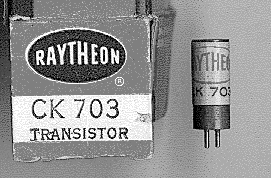The History of the TransistorThe transistor was invented at Bell Laboratories in December 1947 (not in 1948 as is often stated) by Bardeen and Brattain. 'Discovered' would be a better word, for although they were seeking a solid-state equivalent to the vacuum tube, it was found accidentally during the investigation of the surface states around a diode point-contact. The first transistors were therefore of the point-contact type and there is some evidence that Shockley, the theorist who was leading the research, was annoyed because he realised that this device was not what he was seeking. At the time he was trying to find a semiconductor amplifier similar to what we now call a junction FET.
Bell Labs kept their discovery quiet until June 1948 (hence the confusion about the date of discovery). They then announced it in a fanfare of publicity, but few people realised the significance of the announcement, and it did not even make the front page of the newspapers. Shockley basically ignored the point-contact transistor, and continued his research in other directions. He modified his original ideas and developed the theory of the junction transistor. In July 1951, Bell announced the creation of such a device. In September 1951 they held a transistor symposium, and licensed their technology for both types of transistor to anyone who paid the required fee of 25 thousand dollars.
This was the start of the transistor industry. Many firms took out a license, old-established tube manufacturers like RCA, Raytheon and General Electric, and brand-new startups like Texas Instruments and Transitron. Most started by producing point-contact transistors, which at the time had better high-frequency behaviour than junction types. However, the junction transistor rapidly became superior in performance, and was simpler and more consistent to manufacture. The point-contact transistor was obsolete by about 1953 in the USA, a couple of years later in England. Only a total of a few million were manufactured, of roughly 120 types (not including experimental lab versions), mostly American.
The first commercial junction transistors were primitive by modern standards, with a maximum collector-emitter voltage of 6 volts, and a maximum collector current of a few milliamps. Particularly notable was the CK722 from Raytheon in 1953, the first mass-produced transistor, which made solid-state electronics affordable to the amateur constructor. Improved types were rapidly developed, extending frequency response, lowering noise levels, and increasing power dissipation.
 The first commercially available transister, the CK703 which was in production in 1948.
The first commercially available transister, the CK703 which was in production in 1948.
In England, two firms had research labs which were not far behind the Americans: Standard Telephones and Cables (STC) and the General Electric Company of England (GEC, no relation to General Electric in the US). Coblenz and Owens book from 1955 contains a photo of very early transistors including an STC point-contact transistor from 1949. GEC also had prototypes at this time, but I have little documentation on them. In France and in Germany, small research programs existed, but no real commercial operation. Then in about 1950, a shark entered this small pond: Philips in the Netherlands set up Mullard, its English subsidiary, as a transistor manufacturing plant. Their goal was to capture 95% of the European market, and they did this within a few years. Their OC series of transistors dominated Europe for about 20 years.
The earliest transistors were made from germanium, a metallic semiconductor. However, it was known that silicon offered advantages in terms of breakdown voltage and power handling ability. Silicon was more difficult to refine because of its higher melting point, but by 1955 the first silicon transistors were commercially available. Texas Instruments played a leading part in the early development of this technology, with its 900 and 2S series of devices.
Courtesy of Mr. Andrew Wylie, amateur transister collector.
Back to History of Ultrasound in Obstetrics and Gynecology.